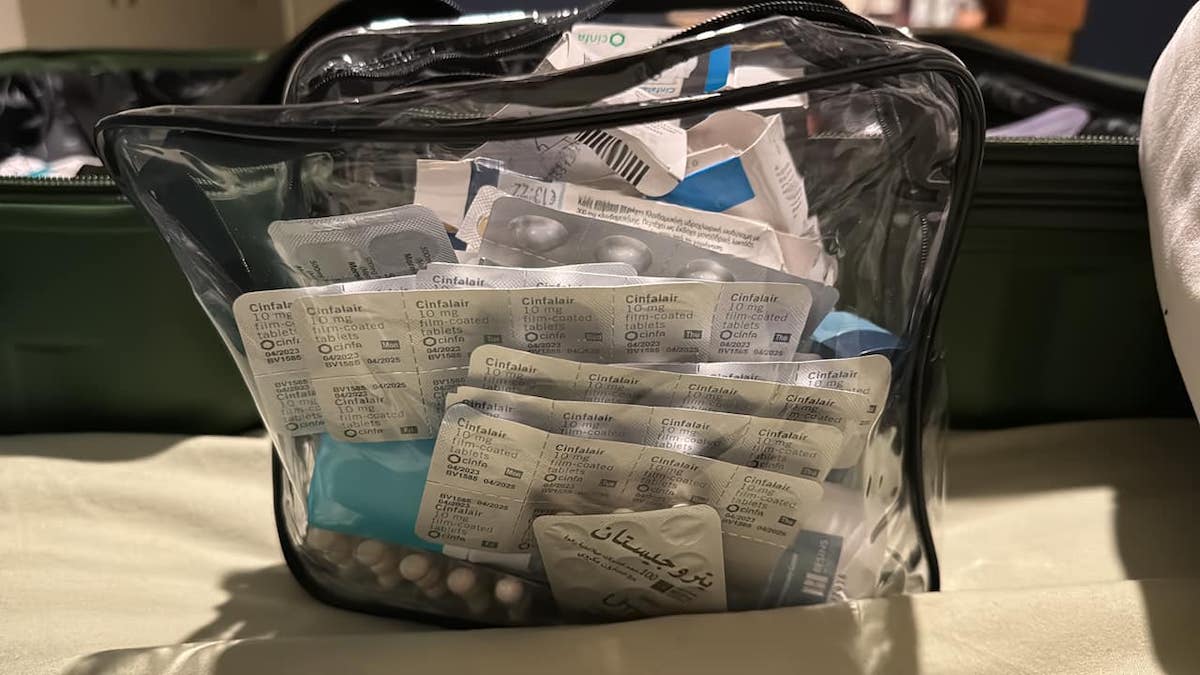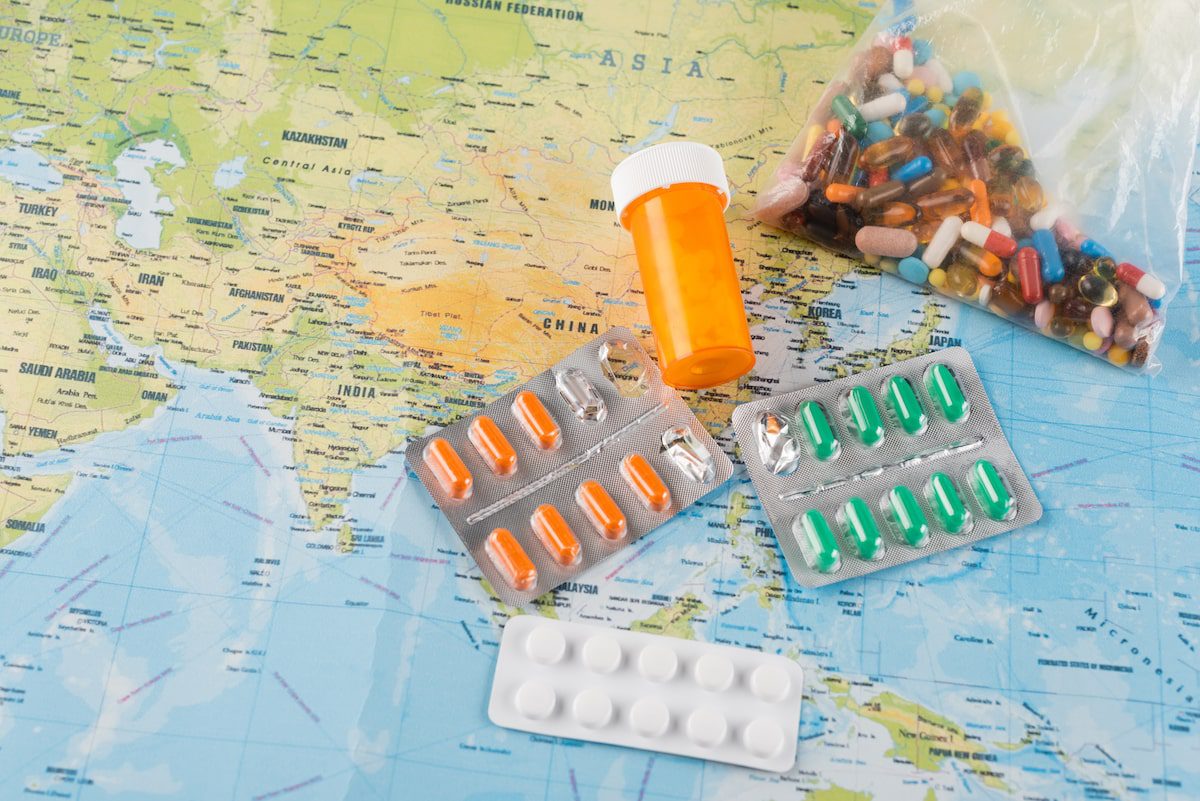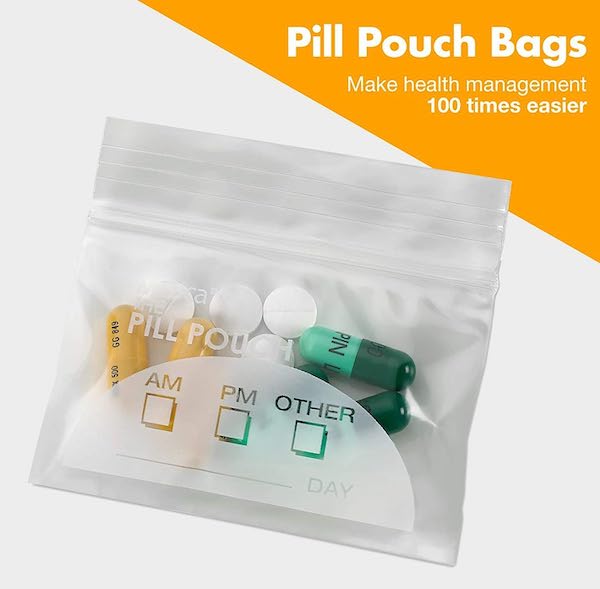Last updated on November 11th, 2024
Featured image: Travelling light can be harder as we age, but it is possible! / Photo by lucigerma via Envato
What to know about packing medication before you go
by Carolyn Ray
Our private Solo Travel Wisdom Facebook group is often the source for many stimulating conversations about life and travel. One of the more recent discussions focused on how to travel with medications, and the challenge of travelling light, especially for longer periods of time, with the plethora of bottles, bags, machines and boxes. As one JourneyWoman reader told me recently, travelling light becomes harder as one ages, because of the medications, mobility devices and comfort items needed, particularly on longer trips.
The question at hand
Tracy M. started the conversation on travel with medication with this question:
“For the ladies who have to travel with lots of meds that take up so much room what do you do?
I’m travelling for a month and won’t put my meds in my checked bag so I take in carry on. I’ve had the tablet organizers but they are big and don’t really help. This bag of meds is bigger than my handbag.
I’m trying to pack more sensible and just wondered how everyone with lots of meds does it?” — Tracy M.

How can we pack light when travelling with medication?/ Photo credit Tracey M.
What government websites say about travel with medication
Make sure you can bring it into another country: Check the Travel Advice and Advisories for the country you plan to visit and make sure your medication is allowed into the country. Some over-the-counter medications, dietary supplements, and herbal and homeopathic products may be illegal in other countries or require prior approval from local authorities. Some U.S. prescriptions are actually considered illegal narcotics in Europe, such as Adderall and other stimulant drugs used to treat ADHD/ADD, as well as some pain and anxiety medications.
Make sure you can bring it on the plane: There is no exercise more fascinating than reviewing the list of items permitted on an airplane. On Transport Canada’s website, there are 50 items listed in the medical category, ranging from wheelchair batteries to medical defibrillators, which are searchable by clicking here. Items such as gel packs, ice packs and diabetic supplies are permitted in both carry-on and checked baggage. Continuous Positive Airway Pressure (CPAP) devices are permitted and the distilled water used by this device is exempted from the liquid restrictions.
Keep prescriptions in original containers: According to Transport Canada’s site, prescription and essential non-prescription liquid, gel and aerosol medication in quantities more than 100 ml are permitted in your carry-on bag. Liquid, gel or aerosol prescription medication should be in original containers with a pharmacy label identifying the medication, and it’s recommended that all medication be packed in your carry-on baggage. Travellers to Canada should contact airlines for specific requirements. You can do that here.
Label medication clearly: For travel to the US, It is recommended that medication be clearly labelled to facilitate the screening process. The Transportation Security Administration (TSA) site says that travellers can bring medically necessary liquids, medications and creams in excess of 3.4 ounces or 100 millilitres in your carry-on bag. The TSA allows larger amounts of medically necessary liquids, gels, and aerosols in reasonable quantities for your flight, but you must declare them to TSA officers at the checkpoint for inspection.
When going through security: Remove medically necessary items from your carry-on bag and place them in a bin or bowl. If a medically necessary liquid, gel, or aerosol alarms additional screening will be required. If the alarm cannot be resolved, the item may not be allowed. You may inform the TSA officer of your disability or medical condition verbally, by using the TSA Notification Card or by providing medical documentation.
Have a travel health kit: The CDC recommends that travellers prepare a travel health kit with items you may need, especially those items that may be difficult to find at your destination. Include your prescription and over-the-counter medicines in your travel health kit and take enough to last your entire trip, plus extra in case of travel delays. Pack medications in a carry-on in case your luggage is lost or delayed.
Bring copies of all written prescriptions: The site advises that travellers should keep medicines in their original, labelled containers. Ensure that they are clearly labelled with your full name, health care provider’s name, generic and brand name, and exact dosage. Bring copies of all written prescriptions, including the generic names for medicines. Leave a copy of your prescriptions at home with a friend or relative in case you lose your copy or need an emergency refill. Ask your prescribing health care provider for a note if you use controlled substances, or injectable medicines, such as EpiPens and insulin.
10 Tips from women about travel with medications
1. Before you leave, check the rules
Make sure you know the rules for each country. — Turi R.
A lot of countries have very strict rules around medication containing opioids or benzodiazepines. It’s never advisable to travel with just the pills in shop-bought dosette boxes. There’s no way of identifying what you are carrying even if you did have the boxes flat packed in your luggage. A lot of airlines allow you an extra bag for medical purposes if you need to carry a lot with you. I’ve done this several times when I’ve been away from home for a long period of time. I just let the airline know in advance so they have a note on their system. — Amanda B.
Check with your airline. Typically they allow medical equipment and meds to be separate. I keep mine in a large fanny pack around my waist when boarding. I think it’s the law to allow lifesaving meds to stay with the owner regardless (including CPAPs too). — Tracy T.
2. Ask your drugstore to use blister packs
Your drugstore will vac pack them for you putting them all by the day and how you are to take them for as long as you need. When I travel to Africa I have them do this for me as it keeps my meds sealed and safe. They will also add the names of the drugs etc on the package. The package is slim and easily packs in your carry-on. — Ev P.
I have my pharmacy put them in a blister pack for me. — Kari P.
Take blister pack versions, not bottles. Take pictures of the box and directions and keep them on your phone, and ditch the boxes. I think you want any meds in original packaging instead of generic pill pouches for the easiest customs and border control. Take along a copy of your pharmacy receipt listing all the Rxs you take. You need what you need to stay healthy. That is souvenir space on the return home once the meds are used up. — Cheryl L.
Perhaps have your pharmacist put them into those blister packs that are divided by days. — Carol R.
3. Use zip-lock bags for medications
Editor’s note: Keeping the above rules in mind, it’s not recommended to use zip lock bags if you’re travelling outside the country. Instead, find an alternative way to package your medication.
Mini Zip Lock bags. I pull the label off the bottle (or just mark it with a sharpie). I take only exactly what I need. If it’s something that must remain in a blister pack, I cut out the number of days I need and mark the dates with a sharpie. I often use the empty pill bottles for stuff like shampoo or lotion, only bringing what I’ll need for the duration and throw the bottle out at the end. May be an image of medicine and text. —Tania L.
I use zip-lock baggies made for meds. I pre-fill before leaving. That way I only carry with me what I need during that day. Otherwise, they would take up way too much room. I also do the same for supplements. Then label with a sharpie AM, PM and SUPP. — Lori W.
I use the small pill ziplock bags and then put them in a small makeup bag. You can get the mini zip locks at the drugstore near the long plastic dispensers. — Judith M.
I buy pill bags from Walgreens. Label each bag with the day and time such as Sunday am, Sunday pm etc putting all the pills in the little bag. Take enough for travel plus one day in case of flight delays or cancellations. — Donna P.
Have your pharmacy print out your prescriptions, and make a copy. Put the number of pills needed in small separate bags with their prescription labelled outside. Keep the official printed list with you. I also print out what the pill looks like but not necessary. If it’s only 3 meds, bring the original bottles but ALWAYS a printout from your pharmacy. It’s official and free. — Ellen W.

Check country regulations before you travel / Photo by LightFieldStudios on Envato
4. Travel with the original bottle
I always travel with ALL My meds in the original bottle and have it in my carry-on. It’s important to have it in the original bottles in case of emergency. — Amit A.
I always carry medication in the original bottle. I never know when I’ll be asked for the prescription, and it is all labelled there. — Eileen F.
It’s one thing to organize pills and capsules, it’s another for those of us with EpiPens, injections, puffers and/or other dispensing devices to carry as well. I use a clear stasher bag but it’s not ideal, especially if traveling a week or longer. It would be great to learn how others do it. — Eden S.
For those who travel with insulin or medicine that has to stay refrigerated, try this travel-sized insulin cooler from 4ALLFAMILY.

Liz M. recommends disposable pill pouches from CVS
5. Use disposable pill pouches
Editor’s note: Assuming you have followed the rules to bring in your medications, using smaller pouches can be a good way to break pills into smaller quantities.
I use these and put my meds in for each day (tuck in another for evening meds). I have photos of the prescriptions in case there are issues but have done it this way for 12 years and 35 countries without a problem. — Kim P.
I’ve done this for a number of years and it works great…never an issue. (I also take photos of the prescriptions). — Christine D.
I purchased small zip bags, poured meds in, carefully peeled the label off the bottle and stuck on the bag. Saved a ton of space and weight. — Liz M.
I bought a seal-a-meal machine and small 2-inch bags. I made up packets for the morning and evening. Put in ziplock bags. Peeled the labels from bottles and taped them to the outside of the ziplock bag. — Theresa G.
First, I would get rid of any cardboard boxes. Next would go the packets. Take the pills out and put them in small plastic pill pouches. Search for “pill pouch” on Amazon. Write on the pouches with a sharpie. — Mary K.
6. Reduce packaging
It’s a real problem trying to travel with all your medication in its original packaging. It’s even harder when they have to be kept refrigerated!! — Virginia M.
Take one box, or cut the box down, for each medication for identification purposes, and keep them together with the box. Easier going through customs checks if it’s not haphazard. — Alison B.
Put in bottles instead of packages. — Fetchin G.
7. Use pill boxes to organize medication
A doctor I was travelling with in East Africa used one of these pill boxes. Every section is labelled with name & expiry date. So handy & light. So I did the same when travelling to Mexico last month for a kayak trip. Worked so well. No problems. But no opioids in them. Cut down on a big bag of pills since on these trips we are supposed to have meds with us to cover all possible arising ailments along with our usual prescriptions. — Bella A.
I use a leather pill organizer. One for every week. All medication is packed day by day. You can then take out the small daily box and put it in your pocket or small purse. — Lotte K. (Find a similar one here.)
8. Keep medication in your carry-on
For a month-long trip, I brought all the original bottles of meds, vitamins and supplements in my backpack. I then bring my first week of pills in a pill organizer and refill each week. Together they nearly filled my entire backpack. For shorter trips, I use just the organizer with the week’s worth of pills and photos of the original bottles in my phone. The only exception is Valium which stays in its original bottle in my purse. — Maria S.
I put half in carry on and half in my checked bag. That way if it gets lost I have time to have the bag found or get more. — Dominique E.
I carry a copy of my prescription summary from the pharmacy in my checked and carry-on, along with a photocopy of the actual prescription. My physician notes on the script that the 6-month supply is due to overseas travel. I also take photos of the scripts with the pill bottle (showing the info label) and the pills themselves. I carry 2 or 3 weeks worth of meds in my carry-on, using a previously used bottle which is half the size. The rest I put in my checked bag. And my daily use is from checked baggage when possible. I do not carry anything that is a powder unless it is in the original package nor do I carry any opioid product.
The longest my luggage went AWOL is 2 weeks. But, I am prepared for this happenstance. I know that I have meds for 2 weeks and I can arrange for refills just in case. And to top off my pre-travel routine, I also take photos of what is in my duffle and backpack. It makes filing a claim much easier. When filing the claim, your insurance rep and airline rep can assist with script refills.— Niina N.
9. How to travel with CPAP machines
I just bring the CPAP machine, not any humidifier requiring water. I always have an APAP auto-adjusting machine as we all have varying needs during the night for pressure adjustment. A CPAP must be adjusted by the provider and does not adjust to actual needs. —Gretchen F.
I’m going to order a travel CPAP machine that is smaller, lighter and doesn’t require distilled water. — Linda J.
Agree on small travel machines. Much easier to carry and mine uses a small round moisture filter that’s good for 30 days once you open the filter packet. I keep several packets on hand. I carry a small extension cord as well as some places don’t have outlets close enough to the bed. Most are universal volts so typically a converter not needed but maybe get a dedicated plug adapter. The travel machines aren’t cheap and probably not covered by insurance but well worth it if you travel a lot. — JoEllen Q.
My Resned Air mini CPAP machine is about the size of my hand, and it’s set up with international voltages with an automatic moisturizer built into the mask. Find a case on Amazon here. — Wendy B.
For those who need to do medical treatments during travel, I need something to hang liquids from. I use a portable IV pole that folds into my suitcase. — Wendy B.
To plug in a CPAP machine, I travel with an extension cord with multiple outlets and USB ports and use an adapter like this one. — Rachelle J.
10. Seek out pharmacies in other countries
My sister and her family get their prescriptions in Canada at Costco. And when they’re in Mexico for a long stay, they go to Costco in a nearby Mexican community. I think this would also work with Walmart pharmacies as they have stores in both Canada & Mexico. And of course, the US. — Jackie H.
Pharmacies in a lot of countries do have medications in case you lose your meds. I lost my Thyroid pills and a Pharmacy in Greece was able to refill my prescription from information I carry on me including my pharmacy and doctor’s name in the states. I actually like the pharmacies I have visited oversees. I have not been to Africa yet, but I have been to parts of Asia and many places in Europe. I lived oversees for 15 years and even had a German Doctor. — Theresa C.
I use one old prescription bottle and put a mix of prescription meds in it for the amount of days I’m gone (I can easily recognize each type). Sometimes I keep others in cards like in your photo, but I’ve also removed them and done the same thing. I take photos of each prescription and send them to my email and store on my phone. I’ve been in over 60 countries and have NEVER had anyone in TSA or anywhere else look at meds or question anything. I know some people think it’s a big issue but this is my experience. — Marianne A.
Don’t forget the basics!
I always take a first aid kit complete with pain, cold/flu, intestinal meds, and antibiotics, bandages, and antibiotic ointment. Add to that hand sanitizer and disinfecting wipes (especially for the planes) and you’re good to go! — Sharon
Disclaimer: We make every effort to provide accurate and up-to-date information. To the extent any recommendations or statements of opinion or fact made in a story may constitute medical advice, they constitute general information and not personal medical advice in any form. Readers of our stories should not act on any recommendation without first taking appropriate steps to verify the information in the stories and consulting a medical professional to ascertain whether the recommendation (if any) is appropriate. Read more in our Terms of Use of this site.
Read More About Wellness here
When Something Goes Wrong: What to Do if You’re Injured While Travelling
Anything can happen on a vacation. Here are some first-hand tips for women to plan for an unexpected injury.
Alcohol-Free Travel: A Different (and Healthier) Kind of Journey
With the growth of de-alcoholized beers, mocktails and sparkling wine, there’s never been a better to time to try alcohol-free travel.
Menopause Travel Packing List for Women Over 50
Our needs change during menopause; these women-recommended products will help women stay cool and comfortable during travel.








0 Comments
We always strive to use real photos from our own adventures, provided by the guest writer or from our personal travels. However, in some cases, due to photo quality, we must use stock photography. If you have any questions about the photography please let us know.
Disclaimer: We are so happy that you are checking out this page right now! We only recommend things that are suggested by our community, or through our own experience, that we believe will be helpful and practical for you. Some of our pages contain links, which means we’re part of an affiliate program for the product being mentioned. Should you decide to purchase a product using a link from on our site, JourneyWoman may earn a small commission from the retailer, which helps us maintain our beautiful website. JourneyWoman is an Amazon Associate and earns from qualifying purchases. Thank you!
We want to hear what you think about this article, and we welcome any updates or changes to improve it. You can comment below, or send an email to us at [email protected].